The following quote was in AP story i read in MIT’s Technology Review this morning about Microsoft licensing Adobe’s mobile Flash and PDF software.
“Flash content is the most prolific content on the web today; it is the way people express themselves on the Internet,” Adobe spokesman Gary Kovacs said.
Hmmm . . . . i suppose it might be true that if you add up all the gigabytes of You-Tube videos that more content on the web is in Flash than any other format. But to say that Flash is the way that most people express themselves seems just a tad disingenuous. You-Tube and other sites convert amateur production into Flash; only a small minority of that content is actually created in Flash. But the reason i’m bothering to post this isn’t to call Adobe out for misleading numbers it’s to raise a warning flag — actually two warning flags
1. Converting amateur production into Flash as You-Tube and other for-profit sites do, effectively moves that content into a proprietary format which resists re-use and re-mix. This is not a good thing.
2. Flash is not easy software to master. If it were true that most conent on the web was created natively in Flash rather than converted into it after the fact, that would mean that content creation had moved decisively into the province of the professional, returning us to the built-in the hierarchies of print and broadcast media. Also not a good thing.
Category Archives: flash
robinson crusoe
David Rothman over at Teleread has a very thoughtful review of a multimedia project coming out of the University of North Carolina which traces the real-world aspects of the Robinson Crusoe story. Rothman asks some very interesting questions about the possible over-use of Flash and the relationship of multimedia to text. (note: he says something very complimentary about me in the piece which makes me uncomfortable recommending it, but the questions he asks are important and very much worth considering.)
ITIN place | 2007 redux: design journal, part 3
 (read parts 1&2)
(read parts 1&2)
[3] I’d just begun hard coding navigational elements for the new ITIN archives, when I suspected Through the Looking-Glass might be an apt, fun read to offset the growing angst around coding. Maybe something in literature would provide the gestalt I felt missing from the minutia of writing lines of functions, booleans, and parameters. Sounds holistic maybe, but this suspicion plus a Wikipedia entry I’d read on Lewis Carol convinced me it’d be the perfect read just now. So, when I was walking through Penn Staten earlier last month, I found a bookseller in the LIRR station and, all excited, I picked up a copy of Alice’s Adventures, with the intentions of breezing through it in order to move onto Looking-Glass. It was nice to open ITIN place the next day to find Stormy Blues For Alice In The Looking Glass. Somehow, the two had already met.
Sally: I’ve been trying to figure out some of the back-end stuff for the past few days, namely, how to get your entire archive to link up to something like this. Do you have any programming / web design wizard friends who might be able to offer me some technical advice?
Alex: God know…. I guess we’ll have to build them manually…some 700 links? yipes.
Alex: I mean, god no….LOL
Sally: Hey, I’m working with a programmer now on a script that will allow the archive to thumbnail images from your entries and automatically load them (& URLs to the corresponding entries) into the Flash file. I don’t know PHP, which is likely the language needed to thumbnail your images automatically, so I’m getting help on that. Once that’s in place, we should be able to (a) play further with layout aspects! and (b) the archive should automatically update every time you publish an entry. Getting closer…
Alex: and it will still do that animated scale up and down trick?
Sally: my PHP programmer who would work on the thumbnail-ing flaked out on me, seems programmers can be as flaky as drummers… So, I set it upon myself to teach myself Flash-based blog applications. At its simplest, it requires a little PHP, a little XML and Flash, all in conversation with what you post online.

Ben: As for PHP gurus… We do in fact have someone working with us right now who’s an experience PHP coder. We’re keeping him pretty busy right now with MediaCommons stuff, but I think he could help you out with this stuff in a few weeks.
Sally: I also imagine there should be more than one way to search / browse the archives. One might be a linear “wall” from month to month that we could click/scroll through, another might be a drop-down menu of months say, to the right of the “wall” of images. Any thoughts on that?
Meanwhile, I’d plotted out on my whiteboard a map of the flash file. It looked to me that there were two methods of approach, interface-wise. Either the zoom function would scale up the size of an entire month’s calendar, and a re-center or panning function would allow the user to focus on a particular entry – or – the zoom function would simply scale up one entry at a time onrollOver (the original idea).
I am (still) drawn to the first idea, even though I’ve put it aside, since that would best recreate the sense of approaching a gallery wall, or landing on the (x,y) of Alex’s blog. But, caveats abound — if an onPress fires the zoom and re-center, then how do you click the entry’s permalink and/or zoom out? Is this overcomplicating things? Here is an example of an unweildy new zoom (an attempt to manage dragging and zooming).
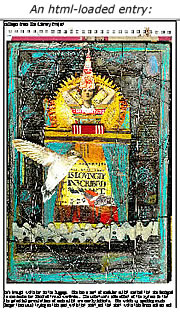 Then I started to think about loading in individual blog entries from the XML. I talked to my friend Mike about this for a while and in exchange for some brownies (although really only out of his extreme kindness and generosity) he constructed an XML format, sample.xml, and guided me on a way to load in the HTML of each individual entry into a small clip.
Then I started to think about loading in individual blog entries from the XML. I talked to my friend Mike about this for a while and in exchange for some brownies (although really only out of his extreme kindness and generosity) he constructed an XML format, sample.xml, and guided me on a way to load in the HTML of each individual entry into a small clip.
The great thing about using the HTML of each entry in the previous example is that it would allow the archives to build completely dynamically. Any changes Alex made in an archived post would reflect in real time in the flash file. Unfortunately, this doesn’t cut down on load time and I can’t coax the videos and animated .gifs to appear (of which there are considerable number). Here is an example of one entry pulled into the Flash file with HTML. CSS can be incorporated, but it’s obviously slow loading.
Mike brought up something I’d wondered too too: are we going to have one XML file for the entire archive? It seems to make more sense for each month to have it’s own.
So, after a few weeks, I caught up with Future of the Book’s expert developer Eddie Tejeda, and we decided to put an XML document within each month. On an exciting note, Eddie devised a great scheme (script) to take screen shots of all of ITIN place’s entries. He’s working on getting the image size down, so as to minimize loading time.
Eddie’s screen shots would load much faster than pure HTML, but it could possibly cut the dynamism. This would build something like this, only faster:
Most of the hard coding of the archive is done. Design matters remain: At the moment, the entries load in rather like a retro computer solitaire game, and drop down menus are disconnected and unskinned. It’s a task to go back and forth between design and developing — I’m just cutting my teeth on some of this and the dryness of programming can dilute creative inspiration (if this is anything to go by). The archive is very close to complete; it will be a thrill to use this gentler beast.
an excursion into old media
![]()
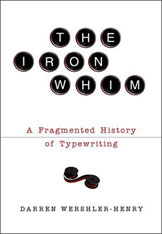 Last summer on a trip to Canada I picked up a copy of Darren Wershler-Henry’s The Iron Whim: a Fragmented History of Typewriting. It’s a look at our relationship with one particular piece of technology through a compound eye, investigating why so many books striving to be “literary” have typewriter keys on the cover, novelists’ feelings for their typewriters, and the complicated relationship between typewriter making and gunsmithing, among a great many other things. The book ends too soon, as Wershler-Henry doesn’t extend his thinking about typewriters and writing into broader conclusions about how technology affects writing (for that see Hugh Kenner’s The Mechanic Muse) but it’s still worth tracking down.
Last summer on a trip to Canada I picked up a copy of Darren Wershler-Henry’s The Iron Whim: a Fragmented History of Typewriting. It’s a look at our relationship with one particular piece of technology through a compound eye, investigating why so many books striving to be “literary” have typewriter keys on the cover, novelists’ feelings for their typewriters, and the complicated relationship between typewriter making and gunsmithing, among a great many other things. The book ends too soon, as Wershler-Henry doesn’t extend his thinking about typewriters and writing into broader conclusions about how technology affects writing (for that see Hugh Kenner’s The Mechanic Muse) but it’s still worth tracking down.
It did start me thinking about my use of technology. Back in junior high I was taught to type on hulking IBM Selectrics, but the last time I’d used a typewriter was to type up my college application essays. (This demonstrates my age: my baby brother’s interactions with typewriters have been limited to once finding the family typewriter in the basement; though he played with it, he says that he “never really produced anything of note on it,” and he found my query about whether or not he’d typed his college essays so ridiculous as not to merit reply.) Had I been missing out? A little investigation revealed a thriving typewriter market on eBay; for $20 (plus shipping & handling) I bought myself a Hermes Baby Featherweight. With a new ribbon and some oiling it works well, though it’s probably from the 1930s.
 Next I got myself a record player. I would like to note that this acquisition didn’t immediately follow my buying a typewriter: old technology isn’t that slippery a slope. This was because I happened to see a record player that was cute as a button (a Numark PT-01) and cheap. It’s also because much of the music I’ve been listening to lately doesn’t get released on CD: dance music is still mostly vinyl-based, though it’s made the jump to MP3s without much trouble. There wasn’t much reasoning past that: after buying my record player I started buying records, almost all things I’d previously heard as MP3s. And, of course, I’d never owned a record player and I was curious what it would be like.
Next I got myself a record player. I would like to note that this acquisition didn’t immediately follow my buying a typewriter: old technology isn’t that slippery a slope. This was because I happened to see a record player that was cute as a button (a Numark PT-01) and cheap. It’s also because much of the music I’ve been listening to lately doesn’t get released on CD: dance music is still mostly vinyl-based, though it’s made the jump to MP3s without much trouble. There wasn’t much reasoning past that: after buying my record player I started buying records, almost all things I’d previously heard as MP3s. And, of course, I’d never owned a record player and I was curious what it would be like.
![]()
So what happened when I started using this technology of an older generation? The first thing you notice about using a typewriter (and I’m specifically talking about using a non-electric typewriter) is how much sense it makes. When my typewriter arrived, it was filthy. I scrubbed the gunk off the top, then unscrewed the bottom of it to get at the gunk inside it. Inside, typewriters turn out to be simple machines. A key is a lever that triggers the hammer with the key on it. The energy from my action of pressing the key makes the hammer hit the paper. There are some other mechanisms in there to move the carriage and so on, but that’s basically it.
 A record player’s more complicated than a typewriter, but it’s still something that you can understand. Technologically, a record player isn’t very complicated: you need a motor that turns the record at a certain speed, a pickup, something to turn the vibrations into sound, and an amplifier. Even without amplification, the needle in the groove makes a tiny but audible noise: this guy has made a record player out of paper. If you look at the record, you can see from the grooves where the tracks begin and end; quiet passages don’t look the same as loud passages. You don’t get any such information from a CD: a burned CD looks different depending on how much information it has on it, but the bottom from every CD from the store looks completely identical. Without a label, you can’t tell whether a disc is an audio CD, a CD-ROM, or a DVD.
A record player’s more complicated than a typewriter, but it’s still something that you can understand. Technologically, a record player isn’t very complicated: you need a motor that turns the record at a certain speed, a pickup, something to turn the vibrations into sound, and an amplifier. Even without amplification, the needle in the groove makes a tiny but audible noise: this guy has made a record player out of paper. If you look at the record, you can see from the grooves where the tracks begin and end; quiet passages don’t look the same as loud passages. You don’t get any such information from a CD: a burned CD looks different depending on how much information it has on it, but the bottom from every CD from the store looks completely identical. Without a label, you can’t tell whether a disc is an audio CD, a CD-ROM, or a DVD.
![]()
 There’s something admirably simple about this. On my typewriter, pressing the A key always gets you the letter A. It may be an uppercase A or a lowercase a, but it’s always an A. (Caveat: if it’s oiled and in good working condition and you have a good ribbon. There are a lot of things that can go wrong with a typewriter.) This is blatantly obvious. It only becomes interesting when you set it against the way we type now. If I type an A key on my laptop, sometimes an A appears on my screen. If my computer’s set to use Arabic or Persian input, typing an A might get me the Arabic letter ش. But if I’m not in a text field, typing an A won’t get me anything. Typing A in the Apple Finder, for example, selects a file starting with that letter. Typing an A in a web browser usually doesn’t do anything at all. On a computer, the function of the A key is context-specific.
There’s something admirably simple about this. On my typewriter, pressing the A key always gets you the letter A. It may be an uppercase A or a lowercase a, but it’s always an A. (Caveat: if it’s oiled and in good working condition and you have a good ribbon. There are a lot of things that can go wrong with a typewriter.) This is blatantly obvious. It only becomes interesting when you set it against the way we type now. If I type an A key on my laptop, sometimes an A appears on my screen. If my computer’s set to use Arabic or Persian input, typing an A might get me the Arabic letter ش. But if I’m not in a text field, typing an A won’t get me anything. Typing A in the Apple Finder, for example, selects a file starting with that letter. Typing an A in a web browser usually doesn’t do anything at all. On a computer, the function of the A key is context-specific.
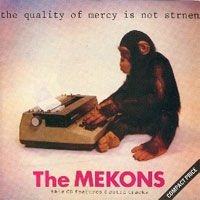 What my excursion into old technology makes me notice is how comparatively opaque our current technology is. It’s not hard to figure out how a typewriter works: were a monkey to decide that she wanted to write Hamlet, she could figure out how to use a typewriter without any problem. (Though I’m sure it exists, I couldn’t dig up any footage on YouTube of a monkey using a record player. This cat operating a record player bodes well for them, though.) It would be much more difficult, if not impossible, for even a monkey and a cat working together to figure out how to use a laptop to do the same thing.
What my excursion into old technology makes me notice is how comparatively opaque our current technology is. It’s not hard to figure out how a typewriter works: were a monkey to decide that she wanted to write Hamlet, she could figure out how to use a typewriter without any problem. (Though I’m sure it exists, I couldn’t dig up any footage on YouTube of a monkey using a record player. This cat operating a record player bodes well for them, though.) It would be much more difficult, if not impossible, for even a monkey and a cat working together to figure out how to use a laptop to do the same thing.
Obviously, designing technologies for monkeys is a foolish idea. Computers are useful because they’re abstract. I can do things with it that the makers of my Hermes Baby Featherweight couldn’t begin to imagine in 1936 (although I am quite certain than my MacBook Pro won’t be functional in seventy years). It does give me pause, however, to realize that I have no real idea at all what’s happening between when I press the A key and when an A appears on my screen. In a certain sense, the workings of my computer are closed to me.
![]()
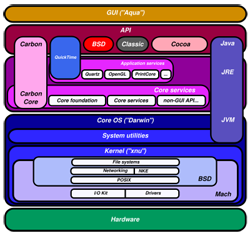
Let me add some nuance to a previous statement: not only are computers abstract, they have layers of abstraction in them. Somewhere deep inside my computer there is Unix, then on top of that there’s my operating system, then on top of that there’s Microsoft Word, and then there’s the paper I’m trying to write. (It’s more complicated than this, I know, but allow me this simplification for argument’s sake.) But these layers of abstraction are tremendously useful for the users of a computer: you don’t have to know what Unix or an operating system is to write a paper in Microsoft Word, you just need to know how to use Word. It doesn’t matter whether you’re using a Mac or a PC.
The world wide web takes this structure of abstraction layers even further. With the internet, it doesn’t matter which computer you’re on as long as you have an internet connection and a web browser. Thus I can go to another country and sit down at an internet café and check my email, which is pretty fantastic.
And yet there are still problems. Though everyone can use the Internet, it’s imperfect. The same webpage will almost certainly look different on different browsers and on different computers. This is annoying if you’re making a web page. Here at the Institute, we’ve spent ridiculous amounts of time trying to ascertain that video will play on different computers and in different web browsers, or wondering whether websites will work for people who have small screens.
A solution that pops up more and more often is Flash. Flash content works on any computer that has the Flash browser plugin, which most people have. Flash content looks exactly the same on every computer. As Ben noted yesterday, Flash video made YouTube possible, and now we can all watch videos of cats using record players.
But there’s something that nags about Flash, the same thing that bothers Ben about Flash, and in my head it’s consonant with what I notice about computers after using a typewriter or a record player. Flash is opaque. Somebody makes the Flash & you open the file on your computer, but there’s no way to figure out exactly how it works. The View Source command in your web browser will show you the relatively simple HTML that makes up this blog entry; should you be so inclined, you could figure out exactly how it worked. You could take this entry and replace all the pictures with ones that you prefer, or you could run the text through a faux-Cockney filter to make it sound even more ridiculous than it does. You can’t do the same thing with Flash: once something’s in Flash, it’s in Flash.
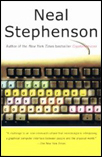 A couple years ago, Neal Stephenson wrote an essay called “In the Beginning Was the Command Line,” which looked at why it made a difference whether you had an open or closed operating system. It’s a bit out of date by now, as Stephenson has admitted: while the debate is the same, the terms have changed. It doesn’t really matter which operating system you use when more and more of our work is being done on web applications. The question of whether we use open or closed systems is still important: maybe it’s important to more of us, now that it’s about how we store our text, our images, our audio, our video.
A couple years ago, Neal Stephenson wrote an essay called “In the Beginning Was the Command Line,” which looked at why it made a difference whether you had an open or closed operating system. It’s a bit out of date by now, as Stephenson has admitted: while the debate is the same, the terms have changed. It doesn’t really matter which operating system you use when more and more of our work is being done on web applications. The question of whether we use open or closed systems is still important: maybe it’s important to more of us, now that it’s about how we store our text, our images, our audio, our video.
social powerpointing, or, the darker side of flash
SlideShare is a new web application that lets you upload PowerPoint (.ppt and .pps) or OpenOffice (.odp) slideshows to the web for people to use and share. The site (which is in an invite-only beta right now, though accounts are granted within minutes of a request) feels a lot like the now-merged Google Video and YouTube. Slideshows come up with a unique url, copy-and-paste embed code for bloggers, tags, a comment stream and links to related shows. Clicking a “full” button on the viewer controls enlarges the slideshow to fill up most of the screen. Here’s one I found humorously diagramming soccer strategies from various national teams:
Another resemblance to Google Video and YouTube: SlideShare rides the tidal wave of Flash-based applications that has swept through the web over the past few years. By achieving near-ubiquity with its plugin, Flash has become the gel capsule that makes rich media content easy to swallow across platform and browser (there’s a reason that the web video explosion happened when it did, the way it did). But in a sneaky way, this has changed the nature of our web browsers, transforming them into something that more resembles a highly customizable TV set. And by this I mean to point out that Flash inhibits the creative reuse of the materials being delivered since Flash-wrapped video (or slideshows) can’t, to my knowledge, be easily broken apart and remixed.
Where once the “view source” ethic of web browsers reigned, allowing you to retrieve the underlying html code of any page and repurpose all or parts of it on your own site, the web is becoming a network of congealed packages — bite-sized broadcast units that, while nearly effortless to disseminate through linking and embedding, are much less easily reworked or repurposed (unless the source files are made available). The proliferation of rich media and dynamic interfaces across the web is no doubt exciting, but it’s worth considering this darker side.
subtitles and the future of reading
After enduring a weeks-long PR pummeling for its dealings in China, Google is hard at work to improve its image in the world, racking up some points for good after slipping briefly into evil. Recently they launched Google.org: a website for the Google Foundation, the corporation’s philanthropic arm and central office of evil mitigation. Paying a visit to the site, the disillusioned among us will be pleased to find that the foundation is already sponsoring a handful of worthy initiatives, along with a grants program that donates free web advertising to nonprofit organizations. And just in case we were concerned that Google might not apply its techno-capitalist wizardry to altruism as zealously as to making profit, they just announced today they’ve named a new director for the foundation by the name of — no joke — Dr. Brilliant. So it seems the world is in capable hands.
One project in particular caught my eye in light of recent discussions about screen-based reading and genre-blending visions of the book. Planet Read is an organization that promotes literacy in India through Same Language Subtitling — a simple but apparently effective technique for building basic reading skills, taking popular visual entertainment like Bollywood movies and adding subtitles in English and Hindi along the bottom of the screen. A number of samples (sadly no Bollywood, just videos or photo montages set to Indian folk songs) can be found on Google Video. Here’s one that I particularly liked:
Watching the video — managing the interplay between moving text and moving pictures — I began to wonder whether there are possibly some clues to be mined here about the future of reading. Yes, Planet Read is designed first and foremost to train basic alphabetic literacy, turning a captive audience into a captive classroom. But in doing so, might it not also be nurturing another kind of literacy?
The problem with contemporary discussions about the future of the book is that they are mired — for cultural and economic reasons — in a highly inflexible conception of what a book can be. People who grew up with print tend to assume that going digital is simply a matter of switching containers (with a few enhancements thrown in the mix), failing to consider how the actual content of books might change, or how the act of reading — which increasingly takes place in a dyanamic visual context — may eventually demand a more dynamic kind of text.
Blurring the lines between text and visual media naturally makes us uneasy because it points to a future that quite literally (for us dinosaurs at least) could be unreadable. But kids growing up today, in India or here in the States, are already highly accustomed to reading in screen-based environments, and so they probably have a somewhat different idea of what reading is. For them, text is likely just one ingredient in a complex combinatory medium.
Another example: Nochnoi Dozor (translated “Night Watch”) is a film that has widely been credited as the first Russian blockbuster of the post-Soviet era — an adrenaline-pumping, special effects-infused, sci-fi vampire epic made entirely by Russians, on Russian soil and on Russian themes (it’s based on a popular trilogy of novels). When it was released about a year and a half ago it shattered domestic box office records previously held by Western hits like Titanic and Lord of the Rings. Just about a month ago, the sequel “Day Watch” shattered the records set by “Night Watch.”

While highly derivative of western action movies, Nochnoi Dozor is moody, raucous and darkly gorgeous, giving a good, gritty feel of contemporary Moscow. Its plot grows rickety in places, and sometimes things are downright incomprehensible (even, I’m told, with fluent Russian), so I’m skeptical about its prospects on this side of the globe. But goshdarnit, Russians can’t seem to get enough of it — so in an effort to lure American audiences over to this uniquely Russian gothic thriller, start building a brand out of the projected trilogy (and presumably pave the way for the eventual crossover to Hollywood of director Timur Bekmambetov), Fox Searchlight just last week rolled the film out in the U.S. on a very limited release.
What could this possibly have to do with the future of reading? Well, naturally the film is subtitled, and we all know how subtitles are the kiss of death for a film in the U.S. market (Passion of the Christ notwithstanding). But the marketers at Fox are trying something new with Nochnoi Dozor. No, they weren’t foolish enough to dub it, which would have robbed the film of the scratchy, smoke-scarred Moscow voices that give it so much of its texture. What they’ve done is played with the subtitles themselves, making them more active and responsive to the action in the film (sounds like some Flash programmer had a field day…). Here’s a description from an article in the NY Times (unfortunately now behind pay wall):
…[the words] change color and position on the screen, simulate dripping blood, stutter in emulation of a fearful query, or dissolve into red vapor to emulate a character’s gasping breaths.
And this from Anthony Lane’s review in the latest New Yorker:
…the subtitles, for instance, are the best I have encountered. Far from palely loitering at the foot of the screen, they lurk in odd corners of the frame and, at one point, glow scarlet and then spool away, like blood in water. I trust that this will start a technical trend and that, from here on, no respectable French actress will dream of removing her clothes unless at least three lines of dialogue can be made to unwind across her midriff.
It might seem strange to think of subtitling of foreign films as a harbinger of future reading practices. But then, with the increasing popularity of Asian cinema, and continued cross-pollination between comics and film, it’s not crazy to suspect that we’ll be seeing more of this kind of textual-visual fusion in the future.
Most significant is the idea that the text can itself be an actor in a perfomance: a frontier that has only barely been explored — though typography enthusiasts will likely pillory me for saying so.
flash memory: “the digital paper age”?
Heads are spinning in response to Samsung’s planned release of a 16 gigabyte flash drive – a string of eight 2GB flash memory cards. Flash memory is solid state data storage, as opposed to the conventional hard drive, which contains spinning mechanical parts. The implication is that the price of memory for computers will soon drop dramatically, as will the amount of energy used to power them. Moreover, you will be able to carry millions upon millions of pages on something the size of a keychain (people will probably start using smaller ones as business cards before too long). There’s definitely something reassuring about the solidity – to rely entirely on a single, rickety hard drive, or a network, to store documents is incredibly risky and unreliable. Plus, these cards are far more tolerant of shocks, bad weather and all around abuse.
Chosun Ilbo describes the remarks of Hwang Chang-gyu, Samsung’s chief executive, who said:
…the development signaled the opening of the “digital paper age.” “In the same way that civilization rapidly progressed after paper was invented 2,000 years ago, flash memory will serve as the ‘digital paper’ to store all kind of information from documents to photos and videos in the future. Mobile storage devices like CDs and hard disks will gradually disappear over the next two or three years, and flash memory will dominate the information age.”
